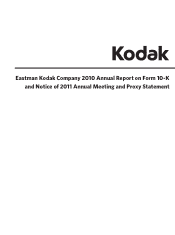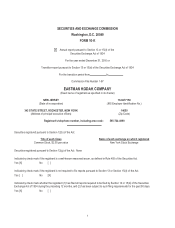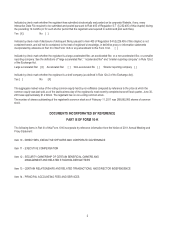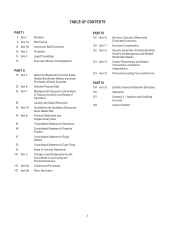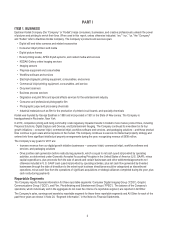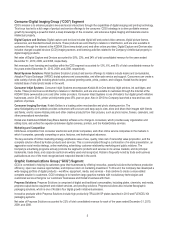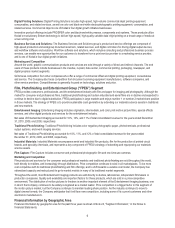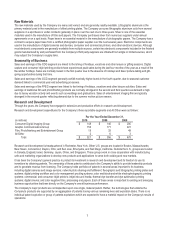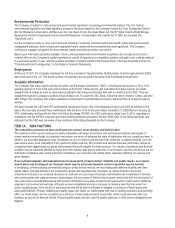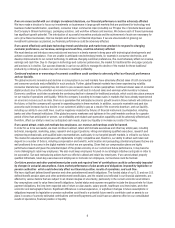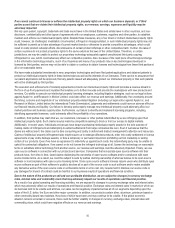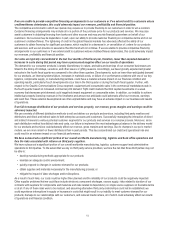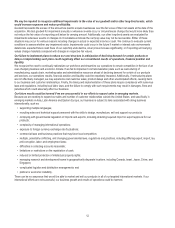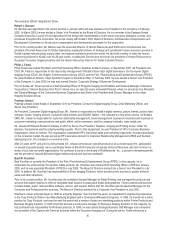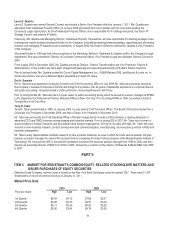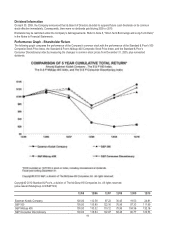Kodak 2010 Annual Report Download - page 11
Download and view the complete annual report
Please find page 11 of the 2010 Kodak annual report below. You can navigate through the pages in the report by either clicking on the pages listed below, or by using the keyword search tool below to find specific information within the annual report.
9
If we are unsuccessful with our strategic investment decisions, our financial performance could be adversely affected.
We have made a decision to focus our investments on businesses in large growth markets that are positioned for technology and
business model transformation, specifically, consumer inkjet, commercial inkjet (including our Prosper line of products based upon
the Company’s Stream technology), packaging solutions, and workflow software and services. We believe each of these businesses
has significant growth potential. The introduction of successful innovative products and the achievement of scale are necessary for
us to grow these businesses, improve margins and achieve our financial objectives. If we are unsuccessful in growing our
investment businesses as planned, our financial performance could be adversely affected.
If we cannot effectively anticipate technology trends and develop and market new products to respond to changing
customer preferences, our revenue, earnings and cash flow, could be adversely affected.
We must develop and introduce new products and services in a timely manner to keep pace with technological developments and
achieve customer acceptance. If we are unable to anticipate new technology trends, for example in consumer electronics, and
develop improvements to our current technology to address changing customer preferences, this could adversely affect our revenue,
earnings and cash flow. Due to changes in technology and customer preferences, the market for traditional film and paper products
and services is in decline. Our success depends in part on our ability to manage the decline of the market for these traditional
products by continuing to reduce our cost structure to maintain profitability.
Continued weakness or worsening of economic conditions could continue to adversely affect our financial performance
and our liquidity.
The global economic recession and declines in consumption in our end markets have adversely affected sales of both commercial
and consumer products and profitability for such products. Further, global financial markets have been experiencing volatility.
Consumer discretionary spending may not return to pre-recession levels in certain geographies. Continued slower sales of consumer
digital products due to the uncertain economic environment could lead to reduced sales and earnings while inventory increases.
Economic conditions could also accelerate the continuing decline in demand for traditional products, which could also place pressure
on our results of operations and liquidity. While the company is seeking to increase sales in markets that have already experienced
an economic recovery such as Asia, there is no guarantee that anticipated economic growth levels in those markets will continue in
the future, or that the company will succeed in expanding sales in these markets. In addition, accounts receivable and past due
accounts could increase due to a decline in our customers’ ability to pay as a result of the economic downturn, and our liquidity,
including our ability to use credit lines, could be negatively impacted by failures of financial instrument counterparties, including
banks and other financial institutions. If the global economic weakness and tightness in the credit markets continue for a greater
period of time than anticipated or worsen, our profitability and related cash generation capability could be adversely affected and,
therefore, affect our ability to meet our anticipated cash needs, impair our liquidity or increase our costs of borrowing.
If we cannot attract, retain and motivate key employees, our revenue and earnings could be harmed.
In order for us to be successful, we must continue to attract, retain and motivate executives and other key employees, including
technical, managerial, marketing, sales, research and support positions. Hiring and retaining qualified executives, research and
engineering professionals, and qualified sales representatives, particularly in our targeted growth markets, is critical to our future.
The market for experienced employees with digital skills is highly competitive and, therefore, our ability to attract such talent will
depend on a number of factors, including compensation and benefits, work location and persuading potential employees that we are
well positioned for success in the digital markets in which we are operating. Given that our compensation plans are highly
performance based and given the potential impact of the global economy on our current and future performance, it may become
more challenging to retain key employees. We also must keep employees focused on our strategic initiatives and goals in order to
be successful. Our past restructuring actions harm our efforts to attract and retain key employees. If we cannot attract properly
qualified individuals, retain key executives and employees or motivate our employees, our business could be harmed.
Our future pension and other postretirement plan costs and required level of contributions could be unfavorably impacted
by changes in actuarial assumptions, future market performance of plan assets and obligations imposed by legislation or
pension authorities which could adversely affect our financial position, results of operations, and cash flow.
We have significant defined benefit pension and other postretirement benefit obligations. The funded status of our U.S. and non U.S.
defined benefit pension plans and other postretirement benefit plans, and the related cost reflected in our financial statements, are
affected by various factors that are subject to an inherent degree of uncertainty, particularly in the current economic environment.
Key assumptions used to value these benefit obligations, funded status and expense recognition include the discount rate for future
payment obligations, the long term expected rate of return on plan assets, salary growth, healthcare cost trend rates, and other
economic and demographic factors. Significant differences in actual experience, or significant changes in future assumptions or
obligations imposed by legislation or pension authorities could lead to a potential future need to contribute cash or assets to our
plans in excess of currently estimated contributions and benefit payments and could have an adverse effect on our consolidated
results of operations, financial position or liquidity.

